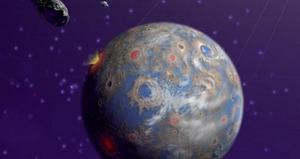Planetary security Key to protecting Earth from asteroids: time
Scientists say that humanity can address the threats from asteroids of any size if given enough time and notice of the asteroid’s existence and trajectory. Even an asteroid the size of the 10-kilometer-wide space rock which scientists hold responsible for the extinction of dinosaurs sixty-five million years ago, can be destroyed, although it would take hitting the asteroid with multiple spacecrafts over a period of several decades.

Meteor impact may have caused worldwide firestorm // Source: colorado.edu
Scientists say that humanity can address the threats from asteroids of any size if given enough time and notice of the asteroid’s existence and trajectory. Even an asteroid the size of the 10-kilometer-wide space rock which scientists hold responsible for the extinction of dinosaurs sixty-five million years ago, can be destroyed, although it would take hitting the asteroid with multiple spacecrafts over a period of several decades.
“If you can hit it with a kinetic impactor, you can hit it with 10 or 100 of them,” said former NASA astronaut Ed Lu, chairman and chief executive officer of the nonprofit B612 Foundation, which aims to protect the planet against asteroid strikes. “And I would submit to you that if we were finding an asteroid that’s going to wipe out all life on Earth, or the majority of life on Earth, that funding is not an issue for launching 100 of them,” Lu added.
NBC News reports that Lu and four other astronauts were guest speakers on 25 October 2013 at the American Museum of Natural History in New York City. The event aimed to draw attention to the dangers asteroids pose to the planet and to discuss ways to diminish the threat.
The planet will continue to collide with asteroids and meteors, although te sizes of the space rocks differ. The February 2013 meteor that hit the Russian city of Chelyabinsk was seventeen-meters-wide and injured more than 1,000 people. The meteor was undetected by the various instruments meant to scan for objects that could collide with the planet.
According to Space.com, scientists have discovered roughly 10,000 near-Earth objects (NEOs), approximately 1 percent of the one million asteroids considered to be a threat to the planet as they move closer. Lu advocates for ramping up asteroid detection efforts. “Our challenge is to find these asteroids first, before they find us,” he said. “You cannot deflect an asteroid you haven’t yet found.”
B612 Foundation is developing an infrared space telescope called Sentinel, which will search for asteroids from a Venus-like orbit. The privately funded Sentinel will be launched in 2018 and is expected to find 500,000 NEOs in less than six years of operation.
If Sentinel and other asteroid detection instruments identify NEOs decades before their potential strike on the planet, scientists will have enough lead time to plan for a successful effort to move the asteroid from Earth’s path. Former Apollo astronaut and B612 co-founder Rusty Schweickart told Space.com that the effort would likely require launching two separate missions. The first would involve a robotic probe on a collision course with the asteroid, knocking it off course by kinetic impact. The second mission would follow up with a “gravity tractor” spacecraft to fly alongside the asteroid, nudging it further with a small but consistent gravitational tug.
The proposed strategy would work for asteroids with about 400 meters in diameter, but larger asteroids would require multiple missions or even send an atomic bomb to explode near the asteroid. Such large asteroids are rare, but smaller asteroids may hit Earth once every 300 years, so it makes sense to focus resources on detecting smaller asteroids that threaten the planet. “We’re not going to be surprised by something that large,” Schweickart said of asteroids similar to the one considered to have killed the dinosaurs. “We will have lots of time to worry about it, or mix our martinis, or whatever we’re going to do.”
